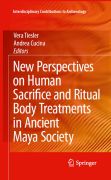
New perspectives on human sacrifice and ritual body treatments in ancient Maya society
Tiesler, V.
Cucina, A.
The central goal of this book is to contribute to the timely discussion and understanding of Maya sacrifice and related posthumous body manipulation. Most school children in the US learn about the Maya and their practices based on their cultural and religious beliefs in their Social Studies classes. But a number of new sites have been discovered, giving an interdisciplinary group of researchers a channel to discuss these acts and their meaning. The editors bring together not only archaeologists but anthropologists, forensic anthropologists, art historians and bioarchaeologists, giving the volume a more complete perspective on these sites and the material culture and biological evidence found there. The field of archaeology is growing to include the physical remains of ritual practice along with the material remains and this book can be seen as an example of who the study of ancient civilizations can be more comprehensive.Brings together an international group of contributors to report on human sacrifice and body manipulation in Mayan culture Can be used comparatively in other cultures which had similar practices Includes explicitly bioarchaeological approaches INDICE: From the contents Introduction.- Funerary or non-funerary? New references in identifying ancient Maya sacrificial and post-sacrificial behaviorsfrom human assemblages.- The creation and sacrifice of witches in Classic Maya society.- Empowered and Disempowered: Terminal Classic Maya Burial and Sacrificial Rituals in the Sibun Valley.- Posthumous body treatments and ritual in the Classic period Northern Petén. A taphonomic approach.- Human sacrifice in Late Postclassic Maya iconography and texts.- Skeletons, skulls and bones in the art of Chichen Itzá.- Sacrifice and ritual body mutilation in Postclassic Maya society. The taphonomy of the human remains from Chichen Itzá’s Cenote Sagrado.- Postclassic sacred spaces and human funerary and non-funerary placements in Champotón, Campeche.- Ritual practices involving the human body among theMaya of Mayapán: A bioarchaeological perspective.- Place of origin of victimsof sacrifice: isotopic evidence.
- ISBN: 978-0-387-09524-0
- Editorial: Springer
- Encuadernacion: Rústica
- Páginas: 322
- Fecha Publicación: 01/10/2008
- Nº Volúmenes: 1
- Idioma: Inglés
